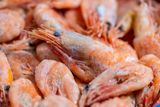
A recent incident involving imported frozen shrimp has prompted a recall by the U.S. Food and Drug Administration (FDA) due to elevated radiation levels. A shipment from Indonesia was halted at U.S. customs after testing revealed the presence of cesium-137 (Cs-137), a radioactive isotope. While the radiation levels were deemed low, the FDA’s action underscores the importance of consumer safety and ongoing monitoring of food imports.
Understanding Cesium-137 and Its Implications
Cs-137 is a byproduct of nuclear fission and does not occur naturally. Instead, trace amounts have become widespread due to decades of nuclear testing and accidents, making its presence in food a concern. Inside the human body, Cs-137 behaves similarly to potassium, distributing into soft tissues and emitting radiation that can damage DNA. High doses can lead to serious health issues, including cancer and acute radiation sickness.
According to the Agency for Toxic Substances and Disease Registry, Cs-137 has a half-life of approximately 30 years, which explains why it remains detectable in the environment long after its initial release. In this case, the FDA found the imported shrimp contained around 68 becquerels per kilogram (Bq/kg) of Cs-137. For context, the FDA’s safety threshold, known as the Derived Intervention Level, is set at 1200 Bq/kg, indicating that while the shrimp were not dangerously radioactive, the levels were unusual enough to warrant further action.
Comparing Radiation Levels in Food
To illustrate the significance of these findings, a comparison can be made with naturally occurring radiation in common foods. A typical banana, for example, emits radiation due to its natural potassium-40 content, producing a radioactivity level similar to that found in the shrimp. It would take approximately 100 bananas to equal the daily background radiation exposure experienced by individuals in the United States. However, the key distinction lies in the sources of this radiation; Cs-137 is entirely manmade, unlike potassium-40.
The levels detected in the shrimp were around 100 times higher than what is generally found in Pacific seafood, which still contains low traces of cesium from historical nuclear tests. Although the detected concentration of 68 Bq/kg does not pose an immediate health threat, the FDA emphasizes minimizing unnecessary exposure to manmade isotopes.
Consumer Guidance and Precautions
The FDA has confirmed that only one shipment of frozen shrimp from the Indonesian supplier was affected, and it did not reach grocery stores. Customs and Border Protection intervened before distribution, and the FDA continues to monitor imported seafood closely.
Consumers who have purchased imported shrimp are advised to check the lot numbers for any potential contamination. If products from the recalled batch are identified, they should be discarded and not consumed. Those concerned about potential exposure after consuming shrimp from the affected lot are encouraged to consult their healthcare provider.
Fortunately, the low radiation levels detected and the timely intervention by regulatory authorities have significantly reduced the risk of contaminated seafood entering the food supply. The FDA’s proactive measures highlight the ongoing commitment to food safety and public health.
This article is for informational purposes only and does not offer medical advice. For further information on food safety and monitoring, visit the FDA’s official website or consult with healthcare professionals.







